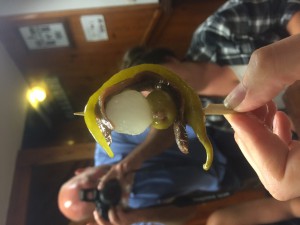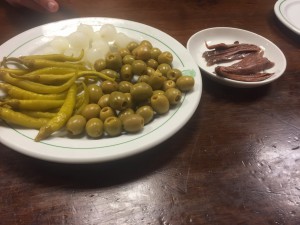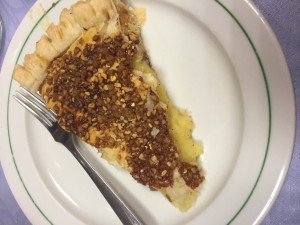When I first purchased my plane ticket to Spain, I was aware that I would be voluntarily immersing myself in a completely new culture. I brought with me five shirts, five shorts, four bathing suits, and one open mind.
Today, my open mind was put to the ultimate test during a “Basque Cooking Class”. My expectation was that the class would go to a kitchen to prepare a meal alongside the chef. To my surprise, this was not true at all. In fact, due to Basque tradition, women were not even allowed to cross the line into the kitchen. They merely came to eat. They were not even allowed to wash dishes. This was shocking to our group of young Americans, some of which were extreme feminists.
In order to get a sneak peak into the kitchen, I gave my camera to Eric Miller, who served as my eyes on the other side of the line. Behind the counter, the chef began to make Marmitako, which is a sort of fish stew. It is thick and chunky with large pieces of potato and tuna. None of the men from class actually cooked. Instead they just observed, so I suppose I did not miss too much in the kitchen.
What I found interesting was the honesty policy that has been implemented in the Basque country. When you go to a bar for pintxos or if you’re a member at a bar, you take your pintxos and you drink your drinks first. Afterwards, you tell the bartender what items you had already enjoyed in order to pay. To show how much you have had to drink, you are expected to keep the lids and pay for them that way. There is a lot more trust between the consumers and the owners here than there is in the United States, and I really admire that part of the culture.
At first when we all sat down, we made a very traditional pintxo. We were given small sword-like toothpicks as well as olives, onion balls, anchovies, and peppers. The word pintxo means to pierce, and that is exactly what we did. First, we slid the pepper onto the spear followed by the anchovy, the olive, and the onion ball. The tail ends of both the pepper and anchovy were wrapped around the olive and the onion and pierced again.
The flavor was very strong. The vinegar was prominent and the peppers were delicious. We could not get too full, though, because this was just the beginning.
Next, we enjoyed a salad and copious amounts of delicious bread. We were given multiple bottles of cider which was much harder to pour than one would think. The idea is to pour the glass from far away, but only real artists seemed to have that skill mastered. As we finished the course, the chef brought out the stew. The students on my end of the table managed to finish two entire pots alone. The students described the taste as fresh, perfect, and “so good”.
For dessert we enjoyed a Patxineta. Apparently this pastry is a Basque version of a French dessert. It is a warm creme surrounded by sugary crust. It was simple and delicious.
Overall, I had a great time during the class. This cooking class exhibited many common traditions of Basque culture, and I would recommend it to all who travel, especially to the women who would like a break from the kitchen.




